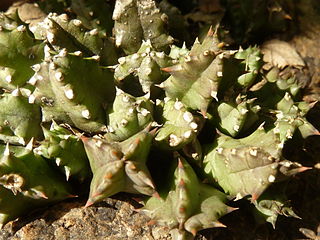
Pachypodium saundersii, the kudu lily, is a succulent plant of the family Apocynaceae. It was named in honour of Sir Charles James Renault Saunders (1857–1931), the Natal Province civil servant and casual plant collector.

Kniphofia is a genus of perennial flowering plants in the family Asphodelaceae, first described as a genus in 1794. The species are native to Africa. Common names include tritoma, red hot poker, torch lily and poker plant.

Dietes is a genus of rhizomatous plants of the family Iridaceae, first described as a genus in 1866. Common names include wood iris, fortnight lily, African iris, Japanese iris and butterfly iris, each of which may be used differently in different regions for one or more of the six species within the genus.

Alsophila capensis, synonym Cyathea capensis, is a regionally widespread and highly variable species of tree fern. It is indigenous to Southern Africa and South America.

Protea comptonii, also known as saddleback sugarbush, is a smallish tree of the genus Protea in the family Proteaceae. It is found in South Africa and Eswatini.

The Maputaland-Pondoland-Albany Hotspot (MPA) is a biodiversity hotspot, a biogeographic region with significant levels of biodiversity, in Southern Africa. It is situated near the south-eastern coast of Africa, occupying an area between the Great Escarpment and the Indian Ocean. The area is named after Maputaland, Pondoland and Albany. It stretches from the Albany Centre of Plant Endemism in the Eastern Cape Province of South Africa, through the Pondoland Centre of Plant Endemism and KwaZulu-Natal Province, the eastern side of Eswatini and into southern Mozambique and Mpumalanga. The Maputaland Centre of Plant Endemism is contained in northern KwaZulu-Natal and southern Mozambique.

Haworthiopsis limifolia, formerly Haworthia limifolia, is a species of flowering plant in the genus Haworthiopsis, native to southern Africa and first described in 1910.

Capparis fascicularis, the zigzag caper-bush, is a plant in the Capparaceae family and is native to Africa.

Asparagus densiflorus, the asparagus fern, plume asparagus or foxtail fern, is a variable evergreen perennial plant, closely related to the vegetable asparagus.

Thamnocalamus tessellatus is a species of bamboo belonging to the family Poaceae, and native to the high mountains of South Africa, Lesotho and Eswatini, lying along the south-eastern part of South Africa. It is found in the Amatola Mountains, the Bamboesberg, which is named for it, and the Drakensberg. Its generic name means "bushy reed", while the specific name means "tiled", an allusion to the rectangular pattern of veins on the leaves. Its common names include mountain bamboo, and Bergbamboes and Wildebamboes in Afrikaans.

Boscia foetida, commonly known as the stink shepherd's tree and the smelly shepherd's bush, is an evergreen shrub or tree that is native to the warmer and drier parts southern Africa. It is found in semi-desert and arid bushveld, and in the west it occurs commonly in areas which are otherwise sparsely wooded. It is known for the particularly unpleasant smell of its flowers which appear during early spring, to which its specific name foetida alludes. Its freshly cut wood likewise has an unpleasant smell, and has traditional medicinal and magical uses, for instance as a protection against lightning. In central Botswana the village of Mopipi is named after this species.

Stapelia leendertziae is a species of succulent plant in the family Apocynaceae. It is native to KwaZulu-Natal province and the Northern Provinces of South Africa, and to Eswatini. Its natural habitats are subtropical or tropical dry shrubland and rocky areas.

Leucospermum gerrardii is an evergreen, mat-forming shrub of mostly about 30 cm (12 in) high and up to 1 m (3.3 ft) in diameter, with branches originating from an underground rootstock. It has narrow leaves, sometimes with three or four teeth near the tip, and prominent, raised, netted to parallel veins. The flower heads are egg-shaped about 5 cm (2 in) in diameter and consist of at first yellow, later orange or scarlet perianths, and long styles reaching far beyond the perianth and together giving the impression of a pincushion. It is assigned to the family Proteaceae. It can be found in South Africa and Eswatini. It mostly flowers between September and November. The species is called dwarf pincushion or soapstone pincushion in English.
Oncocalyx quinquenervius is a parasitic plant species in the family Loranthaceae native to South Africa. It is also known as banded matchflower.

Drypetes arguta, commonly known as the water ironplum, is a species of small tree or large bush in the family Putranjivaceae. It is native to tropical East Africa. It was first described in 1920 by the English botanist John Hutchinson, who named it Cyclostemon argutus. It was later transferred to the genus Drypetes.

Dianthus basuticus, called the Drakensberg carnation, Lesotho carnation, Lesotho pink, hlokoa‑la‑tsela in the Sesotho language and Lesothose wilde angelier in Afrikaans, is a species of Dianthus native to South Africa and Lesotho.

Euphorbia mauritanica, commonly known as yellow milk bush or golden spurge, is a species of plant in the family Euphorbiaceae native to Africa.

Huernia hystrix, the porcupine huernia, is a species of flowering plant in the family Apocynaceae, native to southeastern Africa. A succulent, it has gained the Royal Horticultural Society's Award of Garden Merit.

Gerbera ambigua is a species of flowering plant in the section Lasiopus of genus Gerbera belonging to the basal Mutisieae tribe within the large Asteraceae family.






















